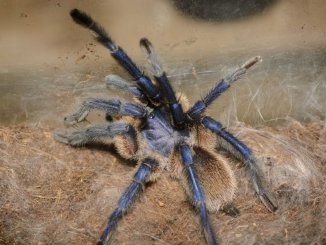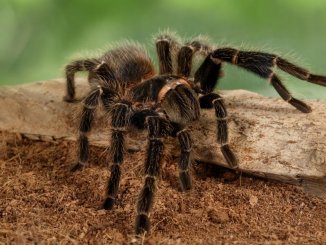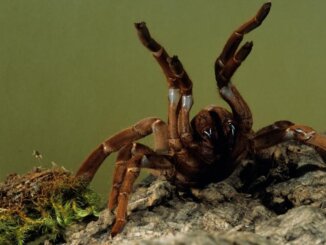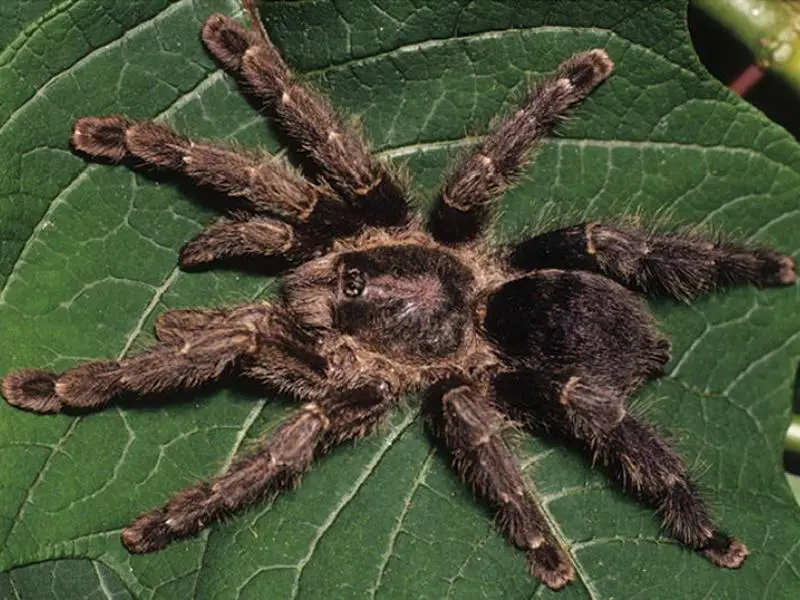
The Avicularia purpurea is a medium-sized tarantula of the Theraphosidae family. This species is native to Ecuador and is known for its intense purple-blue iridescence.
The Avicularia purpurea is relatively easy to care for because of its peaceful temperament, hardy nature, and unfussy eating habits.
Avicularia Purpurea Overview
| Common name | Purple pinktoe tarantula, Ecuadorian purple tarantula, purple tree tarantula, Ecuador purple pink toe tarantula |
| Scientific name | Avicularia purpurea |
| Natural habitat | Amazon region, agricultural areas, Ecuador |
| Adult size | Up to 5.1 inches |
| Average lifespan | Females up to 12 years, males up to 4 years |
| Diet | Carnivore |
| Housing | 16-by-12-inch vivarium, 70–78°F, 65%–80% humidity, foliage, branches, cork bark, hiding spots |
| Experience | Beginner |
Origin
The purple pinktoe (Avicularia purpurea) is a new world tarantula native to Ecuador, where it inhabits the Amazon rainforest and agricultural areas. Purple pinktoe tarantulas aren’t considered endangered and are common in the pet trade.
The Avicularia purpurea is an arboreal species, meaning the tarantula is well-adapted for climbing and builds its nest in trees, bushes, hollows, and thick foliage.
Appearance and Behavior
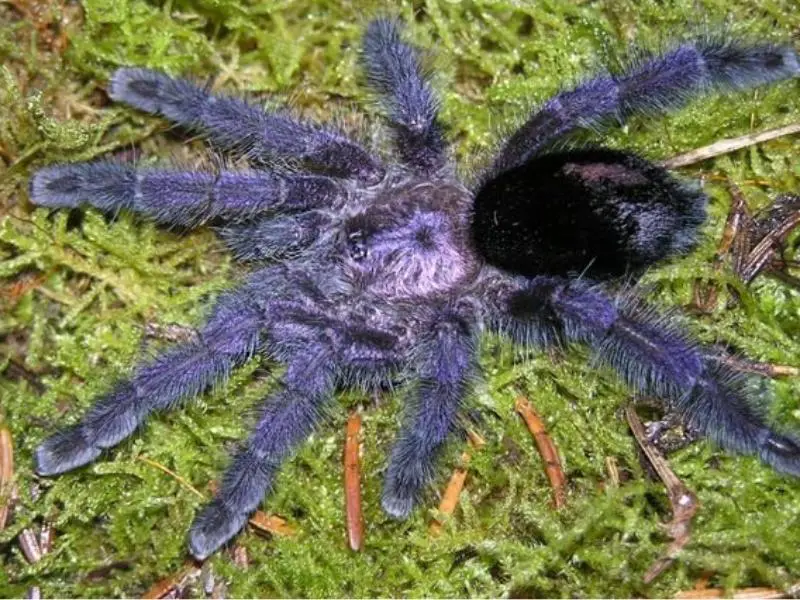
The Ecuadorian purple tarantula is a medium-sized species with an agile build, long legs, and short, stinging hairs. The tarantula gets its name from the vibrant purple hue that spans across its body. The abdomen is jet black.
Sexing purple pinktoe tarantulas is easy, especially at full maturity. Males are smaller, thinner, and grow quicker than females.
Size and Lifespan
The purple pinktoe tarantula grows up to 5.1 inches in length. Males have an average leg span of 3 to 4.5 inches, while females typically have a leg span of 4 to 5 inches.
Purple tree tarantulas live for up to 14 years with proper care. However, males have a significantly shorter lifespan, with most only living for 3 to 4 years.
Temperament
The purple pinktoe tarantula is a peaceful, skittish, and fast-moving spider that spends most of its time climbing and building nests within trees. The tarantula rarely bites and its main means of defense is its stinging hairs.
While cannibalism is uncommon in this species, purple pinktoe tarantulas still exhibit territorial aggression and shouldn’t be housed together.
Housing Purple Tree Tarantula
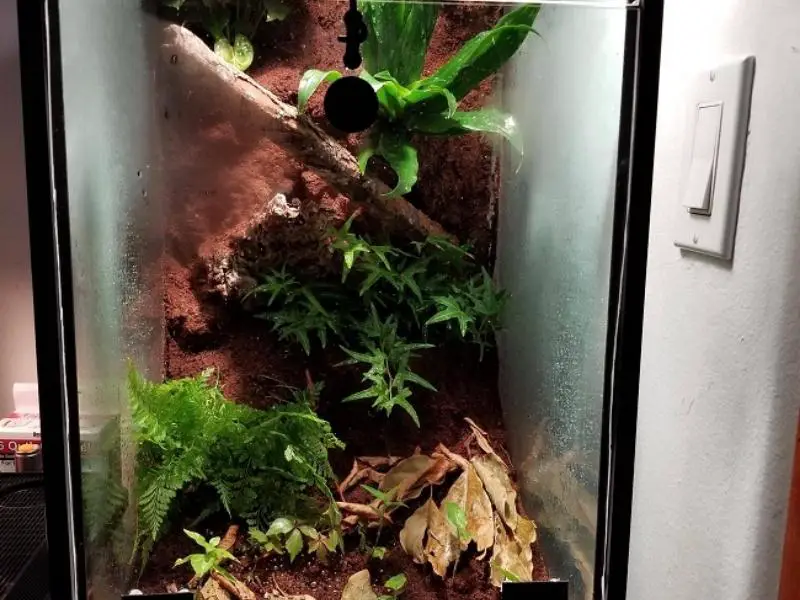
The Avicularia purpurea thrives in warm, humid environments with plenty of climbing spots and hiding places. Simulate these living conditions in the enclosure to give the tarantula the best chances of survival.
This species is best kept in a tall vivarium with a secure lid. Also opt for a vivarium that opens from the side, because reaching down into the enclosure often startles purple tree tarantulas and can disturb their delicate webbing.
Enclosure size
A mature Avicularia purpurea requires an enclosure that measures at least 16 inches tall and 12 inches wide. The vivarium should be two to three times wider than the leg span of the tarantula.
An enclosure with plenty of vertical space allows the purple pinktoe tarantula to engage in its natural climbing behavior.
Lighting
Special UVB lighting isn’t required, though 8 to 12 hours of low lighting per day gives the spider a sense of time and accentuates its vibrant coloration. Ensure there’s shaded spots throughout the vivarium.
Avoid exposing the enclosure to direct sunlight, which can harm the tarantula and affect temperature and humidity levels.
Temperature and Humidity
Purple pinktoe tarantulas should be kept in temperatures between 70 and 78°F for their health and wellbeing. If the room temperature drops below 70°F, place heating pads underneath the enclosure.
Hobbyists should also establish a temperature gradient, meaning the enclosure has both cool and hot zones, to allow the tarantula to better regulate its internal body temperature.
Maintain a humidity level of 65% to 80% to reduce the chances of stress and illness. Dampening the substrate, a large water dish, and light misting every few days can help increase the humidity. Mist more frequently during molting periods, though avoid spraying near the tarantula and its webbing.
Although the Avicularia purpurea favors humid environments, the vivarium must still have cross-ventilation to prevent it from becoming stuffy and excessively damp.
Use a hygrometer and thermometer to monitor humidity and temperature levels.
Substrate and Decoration
A deep substrate isn’t necessary because purple pinktoe tarantulas don’t burrow and spend most of their time above the ground.
Line the bottom of the vivarium with a substrate that retains moisture well and isn’t abrasive. Suitable options include peat moss, vermiculite, and coconut fiber. The substrate should be 2 inches thick.
Create climbing areas with logs, cork bark, branches, artificial foliage, and vines. Ensure these climbing materials are spread throughout the vivarium and at different heights. Purple pinktoe tarantulas are also skittish and need plenty of hiding places to feel at ease.
Add a water bowl for the tarantula to drink from and bask in.
Cleaning
Spot cleaning the enclosure daily helps prevent the buildup of harmful bacteria and foul odors. Use tongs to remove waste, leftover food, molted skin, and moldy substrate, being careful not to disturb the spider or damage its webbing. Rinse out the water dish every few days.
Deep clean the enclosure up to two times per year, which involves replacing the substrate, sanitizing decorations, and washing the vivarium with warm water. Don’t use cleaning supplies that contain chemical products.
Purple pinktoe tarantulas should be moved into a separate enclosure before deep cleaning begins.
To deep clean the enclosure, follow these steps:
- Once the tarantula is in view and appears settled, carefully open the side panel of the vivarium
- Gently place an open container on top of the tarantula
- Slide a piece of sturdy cardboard underneath to block the opening
- Release the tarantula into the other enclosure
Purple pinktoe tarantulas are extremely skittish, so always remain calm and don’t make sudden movements. The separate enclosure should have the same setup as the main enclosure.
Purple Pinktoe Tarantula Care
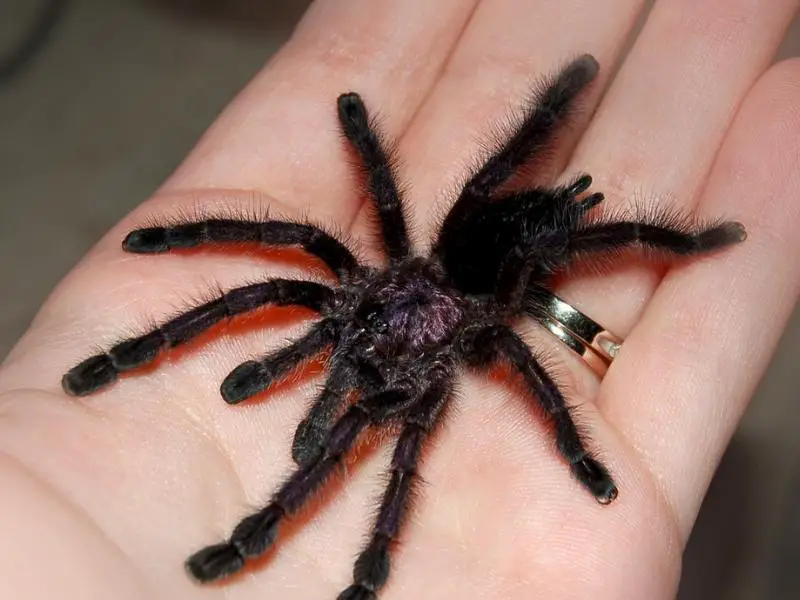
The Avicularia purpurea is relatively easy to care for because of its peaceful, hardy nature, though the tarantula is timid and shouldn’t be handled.
Feed the purple pinktoe tarantula a protein-rich diet and ensure it always has access to clean water.
Food and Water
The purple pinktoe tarantula is a carnivore with a voracious appetite. In the wild, the spider feeds on lizards, small rodents, waxworms, and insects such as wax moths and cockroaches.
Purple pinktoe tarantulas aren’t picky eaters and will take most foods in captivity. Ideal options include gut-loaded crickets, dubia roaches, and mealworms. These foods are cheap and readily available in local pet stores.
Adult tarantulas should be fed around four insects every 5 to 10 days, while juveniles should be fed three times per week to support their growth. Reduce the feeding frequency during molting periods.
The water bowl should be shallow enough for the tarantula to get in and out as it pleases. Top up the dish with fresh water daily.
Handling
Avoid handling the purple pinktoe tarantula because it’s fast moving, prone to stress, and has stinging hairs that, while not deadly to humans, can cause irritation and pain.
Handling can even lead to life-threatening injuries if the tarantula gets startled and jumps out of your hand.
Common Health Issues
Purple pinktoe tarantulas are relatively healthy, though improper conditions can cause them to fall sick. Keep the enclosure well-ventilated, warm, moist, and clean. Common health issues to watch out for include:
- Mold or fungus outbreak: An outbreak can lead to severe sickness in purple pinktoe tarantulas. Inspect the substrate daily for signs of mold and fungus and spot clean if necessary, or replace the substrate completely if the outbreak is throughout the enclosure
- Dehydration: A lack of moisture can cause the tarantula to dry up and eventually die. Symptoms include curled legs, lethargy, and a shrunken abdomen. Use a moist substrate and top up the water bowl daily to prevent dehydration
Molting
Young tarantulas shed more frequently than adult tarantulas. Mist the vivarium daily during molting periods — tarantulas need a lot of moisture to properly and safely shed their exoskeleton.
Signs of molting include loss of appetite, lethargy, and the tarantula lying on its back. Avoid disturbing the purple pinktoe tarantula during this time.
Breeding
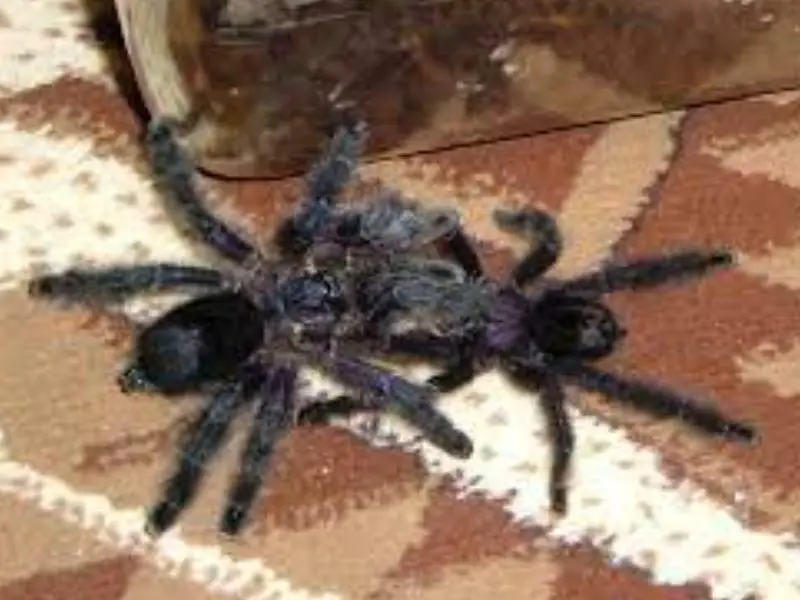
Avicularia purpurea are relatively difficult to breed in captivity as females are often aggressive toward males. However, purple pinktoe tarantulas do breed more readily than other tarantula species, especially in an ideal environment. The female produces an egg sac that contains around 50 to 100 eggs on average.
Follow the steps below to breed a pair of purple pinktoe tarantulas:
- Introduce the male into the female enclosure. Ensure the male is placed far away from the female, ideally the opposite end of the vivarium
- Watch closely as the male approaches the female. Courting behaviors include drumming, twitching, and rubbing the substrate. The pair will lock together during mating
- Separate the pair if the male backs off, a fight breaks out, or the female shows signs of aggression
- Remove the male immediately once the mating process has finished
- After a successful mating, feed the female more frequently to give her the energy to produce an egg sac. Her abdomen will become noticeably plump within one to five months
- Avoid feeding or disturbing the female once she begins to prepare her egg sac. Signs include appetite loss and excessive webbing. The eggs will hatch within six to eight weeks
- Move newly-hatched spiderlings into a separate, small enclosure for the best chances of survival
- Feed spiderlings daily on a diet consisting of protein-rich small insects, like pinhead crickets
Choosing and Buying a Avicularia Purpurea
The Avicularia purpurea is a docile, attractive, and hardy tarantula that’s suitable for beginner and experienced hobbyists alike. This species is uncommon in pet stores, though there are plenty of reputable breeders throughout the world.
Purple pinktoe tarantulas cost between $20 and $150 on average, depending on age, health, size, and breeder. Females are also more expensive than males.
Don’t buy tarantulas that appear shriveled, dull, lethargic, or exhibit uncoordinated movements. Healthy, well-adjusted tarantulas appear alert and have a good appetite.

